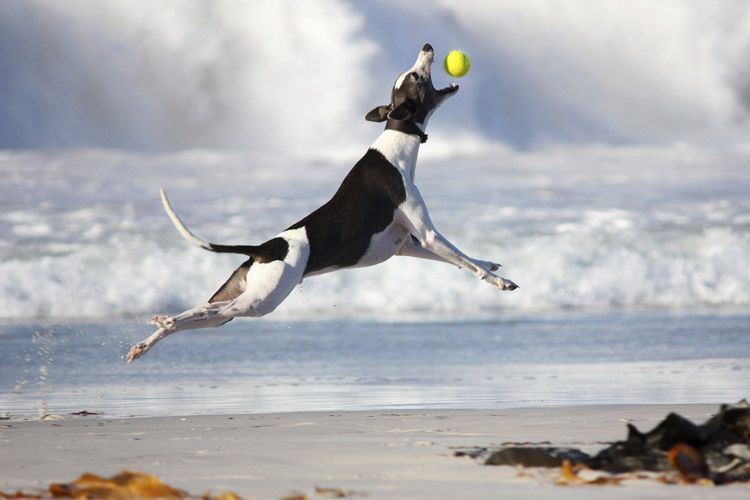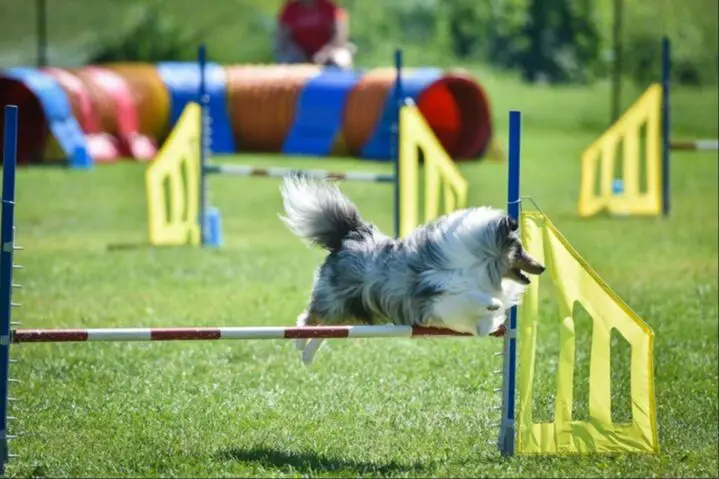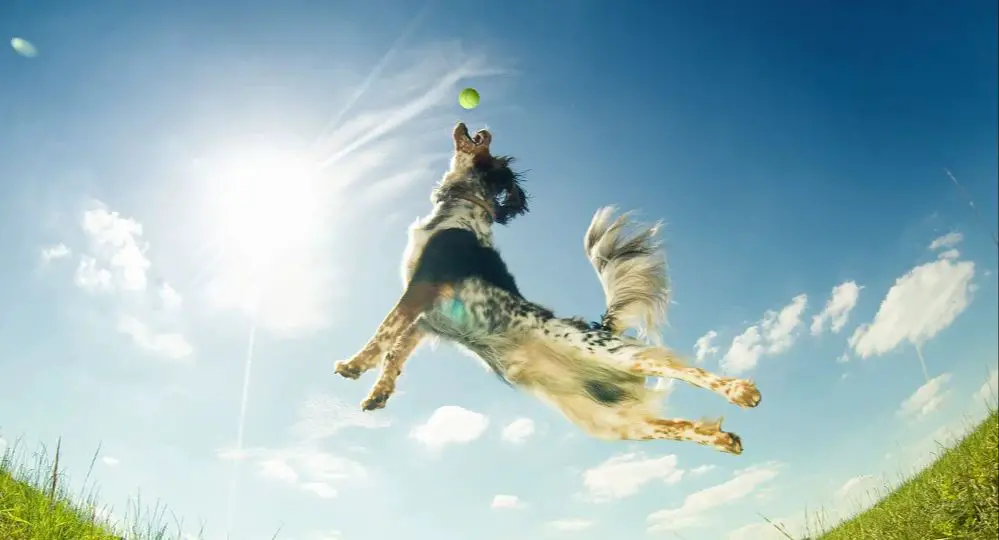Introduction
Dog jumping records measure the incredible athletic feats that certain breeds of dogs are capable of. While all dogs can jump to some degree, certain breeds have become famous for their extraordinarily high jumps. Top canine athletes demonstrate an amazing vertical leap that showcases the power in their hind legs. The current world record for the highest jump by a dog is held by a greyhound named Cinderella May. Her amazing jump of 6 feet 4 inches still stands as the highest verified leap achieved by a dog.
Current Record Holder
The current highest jump record for a dog is held by Feather, a Belgian Malinois. Feather set the record with a vertical jump of 191.7 cm (75.5 in) on September 14, 2017 in Frederick, Maryland, USA (Guinness World Records).
Feather is owned and trained by her handler, Cassandra Bodzewski. Feather was 5 years old when she set the world record. The Belgian Malinois is a herding breed known for its athleticism and jumping ability.

About the Record Jump
The highest jump by a dog is 191.7 cm (75.5 in), and was achieved by Feather (USA) in Frederick, Maryland, USA, on 14 September 2017 https://www.guinnessworldrecords.com/world-records/23431-highest-jump-by-a-dog. Feather is a Belgian Malinois who was trained by her owner John Brant. The jump was officially measured and verified by officials from Guinness World Records.
The record jump took place at an agility course competition. Feather cleared a jump that was set at the record height of 191.7 cm or 6 feet, 3.3 inches. She had several attempts, building up speed and momentum each time before making the successful record leap over the high jump bar without knocking it off.
Training for the Record
The record-holding dog likely followed an intensive training regimen to build up to such an incredible jump. According to https://97x.com/dog-world-record-vertical-jump/, achieving a world record jump requires daily practice and training. Dogs work on conditioning exercises like swimming and running to build muscle strength and stamina. They also practice technical drills by starting with lower jump heights and distances, then gradually increasing the challenge. Trainers use toys, treats, and praise as motivation to encourage the dog to leap as high as possible.
Trainers emphasize building hind-end strength, as that provides the power for a dog’s jump. Specific exercises like cavalettis, box jumps, and high step-overs target the hind muscles. Core strength is also important for achieving proper form in the air. Exercises like sit-ups with a physioball help dogs develop a strong core. With this intensive daily training regimen focused on conditioning and technique, dogs can work up to record-breaking jumps through gradual progression.

Other Notable Jumping Dogs
While the current world record high jump belongs to a greyhound named Cadeau, there have been many other impressive high jumping dogs over the years. Some of the top contenders include:
Flyer – A Belgian sheepdog that held the high jump world record in the early 1900s at 6 feet 9 inches. He was renowned for his graceful jumping style.
Stilts – A greyhound in the 1930s that jumped 6 feet 6 inches. He came close to beating the record but ultimately fell just a few inches shy.
Arnie – A Jack Russell terrier mix adopted from a shelter who could jump over 5 feet high. He toured around showcasing his leaping abilities in the early 2000s.
Ashley Whippet – A whippet from the 1970s who jumped 6 feet 3 inches in competitions. She was one of the top canine athletes of her time.
Droopy – A cocker spaniel who achieved a 5 foot 10 inch jump in the 1990s. His energetic spirit and determination made him a jumping star.
While they may not officially hold records, these amazing dogs pushed the limits on high jumps and paved the way for record-breaking jumpers like Cadeau.
Jumping Dog Competitions
There are several major competitions for high jumping dogs around the world. Some of the most well-known include the Purina Incredible Dog Challenge, the Westminster Kennel Club Dog Show, and Crufts.
These competitions typically have different event categories based on the dogs’ sizes and breeds. Common categories include small dogs under 15 inches, medium dogs 15-20 inches, and large dogs over 20 inches. There may also be specific events for certain breeds like Greyhounds.
The rules and format can vary between different competitions but generally involve the dog jumping over incrementally higher bar heights. The bar begins at a low height, usually around 1 foot, and is steadily raised until only one dog remains who can clear the top height without knocking the bar off.
Dogs get three chances at each height. If they knock the bar off twice, they are eliminated. The last dog standing is the winner. Handler assistance like tossing treats over the jump is usually not allowed.
The world record heights tend to be set at the major national and international competitions like the Purina Incredible Dog Challenge. This annual event holds the Guinness World Records for the highest jump by a dog.
According to Guinness World Records, the highest jump cleared by a dog is 6 feet 6.75 inches by a Greyhound named Augie in 2014 at the Western Canadian Dog Agility Championships in Canada.
Why Dogs Jump So High
Dog breeds range in their abilities to jump high, but all dogs have physical traits that enable them to jump to far heights compared to humans. Some dogs, like the Belgian Malinois, are especially known for their jumping abilities. According to Quora, dogs can jump so high because of their powerful hind legs and flexible spines.
Dogs have an anatomical structure that facilitates jumping. Their hind legs contain powerful muscles that store kinetic energy when bent and release it when the legs straighten to launch them upwards. Dogs also have flexible spines that allow their back to arch and extend, gaining height. Their front legs help pull their bodies up to further increase how high they can jump.

Additionally, dogs have a lower center of gravity than humans since they have four legs and stand closer to the ground. This lower center of gravity gives them better balance and stability when launching upwards into a jump. Their light yet muscular bodies are built for agility and athletics.
Certain breeds like Belgian Malinois, Greyhounds, and Australian Shepherds have been selectively bred to excel at jumping. Their long, lean muscular legs and flexible spines allow them to jump several feet into the air from a standstill. Meanwhile, short-legged breeds like Dachshunds and Corgis tend to stay closer to the ground when jumping due to their anatomy.
So while individual dogs will vary in jumping ability, most can jump much higher than humans due to their specialized anatomy and animal athleticism. Their powerful hindquarters, flexible spines, balance, and agility give them a biological advantage for explosive vertical jumps.
Training Tips
Training a dog for high jump competitions requires dedication, patience, and proper technique. Here are some tips for getting started:
Begin training at a young age. Puppies’ bones, joints and muscles are still developing so starting jumps low and slow will help build strength over time. Start with short jump lengths and low heights, gradually increasing over many training sessions.
Use treats and toys for motivation. Reward your dog immediately after a successful jump to reinforce the behavior. Play fetch with a favorite toy over low jumps, gradually increasing the height as your dog is ready. The reward gives them incentive to keep jumping higher.
Build confidence. Start training low jumps with lots of encouragement and praise. Some dogs may be hesitant at first. Build up slowly while ensuring a positive, fun atmosphere so your dog gains confidence in their jumping ability.
Focus on technique. Approach jumps at an angle rather than straight on. Use guiding commands like “over!” Practice the arc your dog needs to complete the jump cleanly. Work on “two-on, two-off” technique landing on the hind legs and taking off from the hind legs.
Avoid over-training. Limit high impact sessions to avoid stress on growing joints. Monitor for fatigue. End sessions on a good note before your dog loses interest.
Use safety precautions. Start young dogs with low heights. Allow proper warm-ups and cool downs before and after sessions. Provide a soft landing area. Identify and avoid health issues that could impact safety.
Consult professionals. Seek advice from training experts, clubs, sports organizations, veterinarians to learn proper methods. Get tips on building your training plan.
With proper technique, encouragement and patience, you can train your dog to reach thrilling heights!
Health Considerations
High and frequent jumping can have negative long-term health effects on dogs, especially on their joints and bones. While most young and fit dogs can handle regular jumping without issue, it’s still important to be mindful of potential injuries.
The forceful landings from big jumps put a lot of stress on a dog’s joints, particularly their elbows and shoulders. This repeated impact can lead to arthritis and joint problems over time. Hip dysplasia is another concern, as the sockets of the hips can become misaligned from the repetitive jarring of landings. According to one source, “As many as 65% of dogs will develop osteoarthritis and joint problems in their lifetime” (GWF Nutrition).
Jumping off of beds, furniture, or other elevated surfaces can also lead to sprains or fractures if a dog lands awkwardly. Puppies should avoid high jumping until their growth plates have closed. Providing ramps or steps can help dogs safely get on and off of furniture without big jumps.
While jumping is part of a dog’s natural behavior, owners of dogs who jump frequently would be wise to take precautions. Providing joint supplements, maintaining a healthy weight, using ramps, and avoiding overexertion are all ways to care for a high-jumping dog’s joints.

Conclusion
In conclusion, we’ve explored the amazing athletic feat of the highest dog jump world record. Sadly, the current record holder Feather passed away in 2015, but her astounding 68 inch vertical leap remains the benchmark other jumping dogs strive to beat. Her intense training and natural agility culminated in a world record that showcases a dog’s tremendous athletic capabilities.
This record jump highlights how high dogs can leap when they possess natural gifts and undergo specialized training. While most pet dogs won’t come close to this record, it reveals their innate jumping ability. Understanding what enables dogs like Feather to reach such heights gives us appreciation for the athleticism of all dogs big and small.
Records are made to be broken, and it’s likely a new top jumping dog will come along someday. But Feather’s prodigious leap will always stand as an amazing athletic feat for the dog world. Her record jump inspired greater interest in canine athletic competitions and revealed new possibilities of what dogs can accomplish. That’s a powerful legacy for one small but mighty Jack Russell Terrier.
